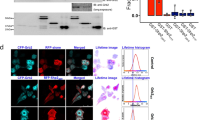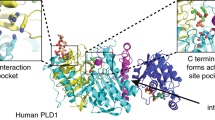Abstract
Our laboratory has recently reported that the enzyme phospholipase D2 (PLD2) exists as a ternary complex with PTP1b and the growth factor receptor bound protein 2 (Grb2). Here, we establish the mechanistic underpinnings of the PLD2/Grb2 association. We have identified residues Y169 and Y179 in the PLD2 protein as being essential for the Grb2 interaction. We present evidence indicating that Y169 and Y179 are located within two consensus sites in PLD2 that mediate an SH2 interaction with Grb2. This was demonstrated with an SH2-deficient GSTGrb2 R86K mutant that failed to pull-down PLD2 in vitro. In order to elucidate the functions of the two neighboring tyrosines, we created a new class of deletion and point mutants in PLD2. Phenylalanine replacement of Y169 (PLD2 Y169F) or Y179 (PLD2 Y179F) reduced Grb2 binding while simultaneous mutation completely abolished it. The role of the two binding sites on PLD2 was found to be functionally nonequivalent: Y169 serves to modulate the activity of the enzyme, whereas Y179 regulates total tyrosine phosphorylation of the protein. Interestingly, binding of Grb2 to PLD2 occurs irrespectively of lipase activity, since Grb2 binds to catalytically inactive PLD2 mutants. Finally, PLD2 residues Y169 and Y179 are necessary for the recruitment of Sos, but only overexpression of the PLD2 Y179F mutant resulted in increased Ras activity, p44/42Erk phosphorylation and enhanced DNA synthesis. Since Y169 remains able to modulate enzyme activity and is capable of binding to Grb2 in the PLD2 Y179F mutant, we propose that Y169 is kept under negative regulation by Y179. When this is released, Y169 mediates cellular proliferation through the Ras/MAPK pathway.
This is a preview of subscription content, access via your institution
Access options
Subscribe to this journal
Receive 50 print issues and online access
$259.00 per year
only $5.18 per issue
Buy this article
- Purchase on Springer Link
- Instant access to full article PDF
Prices may be subject to local taxes which are calculated during checkout








Similar content being viewed by others
References
Ahn BH, Kim SY, Kim EH, Choi KS, Kwon TK, Lee YH et al. (2003). Mol Cell Biol 23: 3103–3115.
Banno Y, Ohguchi K, Matsumoto N, Koda M, Ueda M, Hara A et al. (2005). J Biol Chem 280: 16319–16324.
Bourgoin S, Grinstein S . (1992). J Biol Chem 267: 11908–11916.
Chardin P, Camonis JH, Gale NW, van Aelst L, Schlessinger J, Wigler MH et al. (1993). Science 260: 1338–1343.
Choi WS, Hiragun T, Lee JH, Kim YM, Kim HP, Chahdi A et al. (2004). Mol Cell Biol 24: 6980–6992.
Cockcroft S . (2001). Cell Mol Life Sci 58: 1674–1687.
Di Fulvio M, Coleoni AH, Pellizas CG, Masini-Repiso AM . (2000). J Endocrinol 166: 173–182.
Egan SE, Giddings BW, Brooks MW, Buday L, Sizeland AM, Weinberg RA . (1993). Nature 363: 45–51.
Exton JH . (1998). Biochim Biophys Acta 1436: 105–115.
Foster DA, Xu L . (2003). Mol Cancer Res 1: 789–800.
Gomez-Cambronero J, Horn J, Paul CC, Baumann MA . (2003). J Immunol 171: 6846–6855.
Hammond SM, Jenco JM, Nakashima S, Cadwallader K, Gu Q, Cook S et al. (1997). J Biol Chem 272: 3860–3868.
Horn J, Lopez I, Miller MW, Gomez-Cambronero J . (2005). Biochem Biophys Res Commun 332: 58–67.
Horn JM, Lehman JA, Alter G, Horwitz J, Gomez-Cambronero J . (2001). Biochim Biophys Acta 1530: 97–110.
Houle MG, Bourgoin S . (1999). Biochim Biophys Acta 1439: 135–149.
Jang IH, Lee S, Park JB, Kim JH, Lee CS, Hur EM et al. (2003). J Biol Chem 278: 18184–18190.
Kim JH, Lee S, Lee TG, Hirata M, Suh PG, Ryu SH . (2002). Biochemistry 41: 3414–3421.
Kyriakis JM, Avruch J . (2001). Physiol Rev 81: 807–869.
Lehman JA, Calvo V, Gomez-Cambronero J . (2003). J Biol Chem 278: 28130–28138.
Li N, Batzer A, Daly R, Yajnik V, Skolnik E, Chardin P et al. (1993). Nature 363: 85–88.
Li S, Couvillon AD, Brasher BB, Van Etten RA . (2001). Embo J 20: 6793–6804.
Liu MY, Cai S, Espejo A, Bedford MT, Walker CL . (2002). Cancer Res 62: 6475–6480.
Lopez I, Arnold RS, Lambeth JD . (1998). J Biol Chem 273: 12846–12852.
Lowenstein EJ, Daly RJ, Batzer AG, Li W, Margolis B, Lammers R et al. (1992). Cell 70: 431–442.
Park JB, Kim JH, Kim Y, Ha SH, Yoo JS, Du G et al. (2000). J Biol Chem 275: 21295–21301.
Park SK, Provost JJ, Bae CD, Ho WT, Exton JH . (1997). J Biol Chem 272: 29263–29271.
Powner DJ, Wakelam MJ . (2002). FEBS Lett 531: 62–64.
Prelich G, Stillman B . (1988). Cell 53: 117–126.
Schlessinger J . (1994). Curr Opin Genet Dev 4: 25–30.
Slaaby R, Jensen T, Hansen HS, Frohman MA, Seedorf K . (1998). J Biol Chem 273: 33722–33727.
Songyang Z, Shoelson SE, Chaudhuri M, Gish G, Pawson T, Haser WG et al. (1993). Cell 72: 767–778.
Songyang Z, Shoelson SE, McGlade J, Olivier P, Pawson T, Bustelo XR et al. (1994). Mol Cell Biol 14: 2777–2785.
Sung TC, Altshuller YM, Morris AJ, Frohman MA . (1999). J Biol Chem 274: 494–502.
Sung TC, Roper RL, Zhang Y, Rudge SA, Temel R, Hammond SM et al. (1997). Embo J 16: 4519–4530.
Xu Y, Seet LF, Hanson B, Hong W . (2001). Biochem J 360: 513–530.
Acknowledgements
We thank Dr J David Lambeth (Emory University) for his generous gift of pcDNA-myPLD2. This work has been supported by a Grant from the National Institutes of Health (HL056653) to JG-C.
Author information
Authors and Affiliations
Corresponding author
Rights and permissions
About this article
Cite this article
Di Fulvio, M., Lehman, N., Lin, X. et al. The elucidation of novel SH2 binding sites on PLD2. Oncogene 25, 3032–3040 (2006). https://doi.org/10.1038/sj.onc.1209340
Received:
Revised:
Accepted:
Published:
Issue Date:
DOI: https://doi.org/10.1038/sj.onc.1209340
Keywords
This article is cited by
-
PA promoted to manager
Nature Cell Biology (2007)



